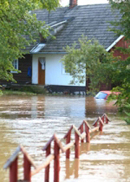Water, water everywhere…
We are getting it in droves here on the East Coast! It’s seeping into our basements, pushing through unprotected and leaky windows, driving up under roofs and penetrating ceilings.
And that’s if you are lucky!
 We’ve been getting lots of calls lately about water-logged basements, dripping ceilings and buckled floor boards. And the damage we see again and again is the result of a poorly engineered house envelope with inadequate water protection or a lack of maintenance over time.
We’ve been getting lots of calls lately about water-logged basements, dripping ceilings and buckled floor boards. And the damage we see again and again is the result of a poorly engineered house envelope with inadequate water protection or a lack of maintenance over time.
There are always options. So keep bringing me your pictures and your sketches. We can talk about the details as well as the “big picture” to make sure your design reflects your tastes as well as the plans you have for today – and tomorrow.
As our long-time clients know-and have come to appreciate even more after the latest storms-is our preoccupation with the house envelope. We include a Whole House Assessment as part of our initial design consultation for a reason. So here’s some advice:
Grade your property away from the house. The best way to ensure a dry interior is to prevent water from reaching it. Grading the ground around your house foundation so it slopes away from the house is the first step. Even if you are on a hill, make sure the ground within five feet of the house slopes away from the foundation.
Keep vegetation at least five feet away from the foundation. Bushes and trees planted 20 years ago or longer could actually be detrimental to your efforts to avoid water problems. That’s because roots can penetrate old rubble and brick foundations and even get through minute cracks in cement and block. Dense vegetation that is too close to your home can also make it difficult to see if the ground around the house has sunk and create a valley you don’t want.
Drain your property. If you live in an area with a high groundwater table, if your home sits at the bottom of a hill, or if your soil is hard rock or clay, you should install a French drain, also called a curtain drain, along the uphill side of the property. During times of heavy rain, this drain will carry excess water to a dry well or a corner of your property, directing it away from the house.
Seal leaky windows. The area between a window frame and the wall is a weak link. Rotted or poorly sealed window sills are also areas where leaks occur. In a driving rain water can enter and damage the wall around the window and even seep down to walls and ceilings below. Foam caulks are useful but are just stop-gap measures. The real problem should be fixed by a professional, who may have to replace rotted sills and remove and re-install exterior window casings to get good seals.
Check your roofs and gutters. Gutters that overflow because of a build-up of leaves can cause damage to your house, especially during heavy rains. Direct the leaders as far away from the house as possible. If you have leaders going to dry wells check that they are still working and not just overflowing and gushing water out at the foundation. Driving rains can also lift poorly laid roof shingles and get to the unprotected under-layment.
So before you start an interior decorating project we suggest you take a hard look at the house envelope, so you can feel safe that future storms will keep the investment you made on the inside high and dry.
